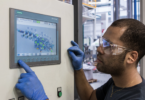Marvel Labs has invented a way to 3D print durable goods – everything from coffee mugs to sinks, faucets, light fixtures, bicycles, and furniture – out of biomass that usually ends up in landfills like used coffee grounds, wood waste and seaweed.
The U.S. startup’s eye-catching products (see the photo of a sink designed by Marvel Labs partner Sandheiden made from 3D printed seaweed) are not just an interesting intersection of artistry and science; they promise to advance sustainability in the manufacturing industry and nearshoring.
Marvel Labs’ innovation could be a needed breakthrough for 3D printers, says Pablos Holman, a U.S. inventor and venture capitalist who made the first investment in Marvel Labs. “Although 3D printers were supposed to be the backbone of the factories of the future and make things people want in an economical fashion they have not yet lived up to the hype,” says Holman. “The reason for that is 3D printers are too slow and the inputs are too expensive and can’t compete with injection molding. The answer to solving that is using an input that is environmentally friendly – leftover biomass – and turning that into products that can be made faster and cheaper so that we get to the point where we can truly automate factories and reshore them.”
It is an entirely new way to doing things and the benefits include unprecedented reductions in costs, carbon emissions and labor, says CEO and co-founder Jake Miller, who has over 19 years of experience in new product development and manufacturing in a variety of industries.
Marvel Labs’ source material is plentiful: There’s over 500 gigatons of biomass globally. In the U.S. alone, 12.2 million tons of wood and 3.7 million tons of wet coffee grounds end up in landfills every year. Some 0.1 million tons of sargassum seaweed that washes up on Mexico’s beaches, traditionally ends up in landfills. Marvel Labs rematerializes the biomass to create sustainable and high-volume products – from Sony Play Station controllers to guitars. The strong yet lightweight properties of the durable products it produces helps localize supply chains while sequestering CO2; helping to tackle climate change and aiding corporations seeking to meet their ESG goals, says Miller.
“Every product may not be a good candidate, but we are actively working towards that future,” says Miller.
It costs less to make durable goods from biomass because the base materials are either free or cheap. Metal powder used in 3D printers typically goes for $120-$740 per kilogram; while plastic powder sells for $100 to $250 per kilogram. Biomass like used coffee grounds is almost always free today. Businesses are happy to have the grounds put to good use and save money on their waste removal fees as a result, says Miller. Marvel Labs gets used coffee grounds for free from local Starbucks stores near its Indiana operations, an arrangement it hopes to expand nationally. Carbonwave, another partner of Marvel Labs, makes products from Sargassum seaweed from Mexican beaches and converts it to a powder for Marvel’s binder jetting operations free-of-charge. Marvel Labs plans on co-locating some of its printers in their facilities to use the seaweed at source. It sources wood waste from sawmills today for pennies a pound, but is in discussions with distributors to use wooden pallets that have gone beyond their useful life. Instead of being sent the landfill, they will be ground into a powder and turned into another product, such as a light fixture.
The combination of cheaper sustainable materials and automation provided by 3D printing adds up to significant time and cost savings for manufacturers, says Miller. For instance, a fully manufactured light fixture can cost $22 to produce with four hours of labor. Additionally, the mold might take 8-12 weeks to produce, usually at a cost of more than $100,0000. Marvel Labs says it can produce the same fixture for a total cost of $4.50 in just a half-hour with a day or two added for final coatings and finishes.
“Most durable goods are not made locally because they can’t compete with foreign supply chains due to the cost of materials and labor, subsidies, and geopolitics, says Miller. “By solving the cost dilemma of using 3D printers with biomass we’re now in the position to reshore manufacturing.”
Marvel Labs is producing white labelled goods for small to medium size clients to market and sell. Large corporations with plans to produce significant volumes of durable goods can partner with Marvel labs. They will be charged a subscription fee, equivalent to the hourly wage of an entry-level factory worker, says Miller. ”The point is to enable people to be eligible for better paying jobs while not passing along their salary increases to the end consumer buying the products.”
Designing The Future Of Physical Goods
Miller, who earlier in his career created significant top-line growth for Fortune 100 and 500 companies in the consumer products, aerospace and energy sectors through new product development and new manufacturing methods, began researching the possibility of 3D printing with biomass waste back in the early 2010’s. The idea came to him after he spent an afternoon working from a local coffee shop and noticed the volume of coffee grounds that were being thrown away. He thought to himself “we should be able to use this material for something,” he says. At the time, industrial 3D printers were too expensive – more than a million dollars – and were only geared towards one-off prototypes, let alone biomass for mass production purposes; so it was tough to make a business model work. Then, about six or seven years later, Miller went to a trade show and realized that 3D printing machines were progressing. Although prices were still relatively high, output was improving. It was enough to inspire him to use his spare time to work in his home garage and come up with ways to turn used coffee grounds into 3D printed products. He teamed up with binder jet printing pioneer Andy Jeffery in 2023 and the two co-founded Marvel Labs.
“It turned out that used coffee grounds was probably the worst biomass material to start with,” says Miller. It’s difficult to properly dry quickly, it creates a static charge when moving through tubing, it bridges in a funnel, it can dissolve with an improper binder, and if the grounds are too fine, it creates dust which can clog the printhead. It forced us to come up with technological solutions to solve the first problem, and then the next, and the next; some of which we may license individually. The silver lining is that the next three sets of different biomass materials were a breeze.”
Binder-jetting machines – which are typically used to print metal, and now through Marvel Labs, biomass– work by spreading layers of powder and covering each layer with a binder, aka, glue. Since the goal was to be sustainable, Marvel Labs has replaced toxic glues with a roster of what it says are industry-first sustainable binders, including one made from bacteria that it has developed and plans to license across multiple industries. “The 3D printing industry feels like it’s at a moment in time dubbed the valley of despair,” says Miller. “Traditional business models, materials, and printers need a paradigm shift. We’re re-imagining the entire concept from the ground up; from the upfront use of new materials to an entirely new generation of 3D printers in development with a 50X output multiplier compared to machines available today. And, thanks to AI, the whole experience could be as simple as typing “a red modern chair,” choosing the AI generated version that you like, and like magic it shows up on your doorstep a few days later.”
Raising Capital And Building a Pipeline of Customers
Marvel Labs’ ultimate goal is to be able to rely on whatever biomass material makes the most sense in the context of a given region, helping manufacturers to nearshore and become more sustainable, says Miller.
“If you are a maker or distributor of durable goods – whether it is sinks or light fixtures, faucets, or car dashboards – and you can replace the plastic and maybe even most of the metal – there are huge potential savings in terms of CO2, supply chain complexity, and cost,” says Miller.
The process will also help enable the circular economy as a byproduct. If you make a bike out of biomass, when it is worn out, you can just grind it into power and make a new one.,” he says. “You don’t need virgin material every time.”
Products made from used coffee grounds or seaweed can be used in a wide variety of applications; from consumer goods to luxury home interiors. Products made from wood waste can be used in the automotive and boating industries.. The company says a virtually unlimited range of colors, textures, weight, and durabilty can be designed directly into the final products made from biomass, making them ideally suited for use in the aerospace and automotive industries.
It makes sense for Marvel Labs to start with highly designed, higher margin products such as light fixtures, says Miller, but it has already began making democratized consumer goods, ready for food safe testing, in partnership with Laughing Man Coffee & Tea, and is considering making wearables such as the Apple watch case “because we could make a ridiculous amount of them using one machine in a few hours,” says Miller. The company is raising venture capital and is looking to partner with traditional manufacturers or retailers across the globe.
“The future will be built on biomaterials, materials that cost almost nothing, and do most of the work,” says Miller. “When combined with automation, it will usher in a new era of abundance and sustainability.”
This article is content that would normally only be available to subscribers. Sign up for a four-week free trial to see what you have been missing.
To access more of The Innovator’s future of manufacturing stories click here.




